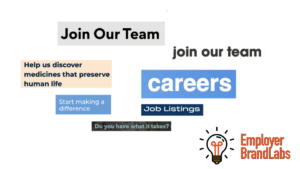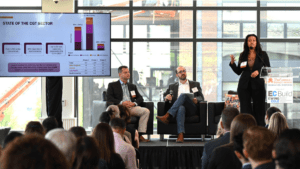
Win the Life Sciences Talent War with Strong Employer Branding
A lot of jobs. A lot of competition for qualified candidates. This is a national trend in the biotech labor market and the job market in the BioHealth Capital Region (BHCR) is no different.
Biotech, Medtech, and pharma companies of all shapes, sizes, and focus areas are struggling to fill vacancies during a growth boom created by the pandemic and advancements in biomanufacturing, cell and gene therapy, and other bleeding-edge sectors. This ongoing boom has created an uber-competitive talent acquisition and retention environment that’s pushing hiring managers, talent leaders, and c-suite executives to evolve and adopt new talent hiring and retention strategies that give them a competitive hiring edge.
Companies and hiring teams that have been successful securing the right life sciences talent pivoted quickly to reshape the candidate experience via stronger employer branding strategies.
These life sciences recognized early that winning the talent wars required greater investment and focus on meeting job candidates where they were and delivering an outstanding candidate experience. This pivot included moving to virtual recruiting events, ZOOM interviews, and online happy hours due to the pandemic, as well as creating a more intentional, cohesive employer brand that resonates with the right talent.
“I’ve been talking with talent leaders, hiring managers, and even job seekers over the last three months and employees have been stagnant in their roles. It’s much safer to stay put when you’re dealing with a global pandemic. Now that we’re coming to the end of lockdown, people are starting to look for advancement again. What we’re starting to see is a massive shift. Companies are putting out more noise in the market and listing more opportunities than we’ve ever seen,” stated Jake Thomas, Director of Employer Brand & Talent Communities at Workforce Genetics.
“I just read a report from Axios that companies could see as much as 40% attrition year over year… I think companies that come out ahead in this are not just going to just rely on traditional means for acquiring talent. They are going to start partnering with the right teams that can deliver high-value audiences and platforms where they can tell their story at scale. We will see organizations start coming to a hybrid model of traditional talent acquisition spend but with new spend to develop more dynamic recruitment marketing collateral to build targeted campaigns. You can’t approach this problem the same way you have in the past with such a massive cultural shift. And on the flip side, when I’m talking to candidates it’s the same story: it’s about this idea of matching up your values with the right employer brand and mission,” he added.
At the root of a strong employer brand is a clear and well-defined workplace culture that reflects a company’s mission, values and spirit. A powerful and magnetic employer brand starts with leadership and early hires forming a unified culture and core belief system that is inculcated into new hires and is maintained even as the company expands. In short, an effective and persuasive employer brand communicates its cultural values and provides a job candidate a sense of where the company is, where it is headed, and what career opportunities exist for the candidate within this narrative.
“Companies need to start taking control of the narrative. They need to tell their story in consumable ways so that people can easily cut through the noise and pick something out and say, ‘Ooh, that’s a mission I want to be a part of’… We’re coming up on one of the more interesting times in talent acquisition I’ve seen in my career,” stated Thomas.
COVID-19 and intense talent competition has forced companies and hiring candidates to get creative. Posting a resume or a job on Indeed or another hiring website just isn’t enough anymore. The talent recruiting and retention landscape has quickly become much more dynamic and active with hiring managers leveraging more tools and job seekers doing the same. Social media, job boards, talent scouts, virtual hiring events, referrals, and building personal and employer brands are all critical elements to those hiring and those looking to get hired.
Local BHCR biotechs like Frederick, Maryland’s RoosterBio, and Rockville, Maryland’s ABL (Advanced Bioscience Laboratories), Inc. were early adopters of this new, employer brand-driven approach to talent acquisition. ABL, Inc. partnered with WorkForce Genetics to host a virtual recruiting event during the height of the pandemic, and RoosterBio explored new virtual hiring approaches to differentiate their brand within a competitive talent market.
“With COVID and with our industry being so competitive, we have to get creative. We’re trying to have that social media presence to create that employer brand to engage with people…we’re really looking at everything and anything to advance the growing needs of our candidates and the resource pools in the area,” stated Diana Elias, HR Director at ABL.
Ed Radwinsky, a life sciences talent expert, stated “A big focus on LinkedIn nowadays; it’s a great way to reach passive candidates. Make sure you have a robust LinkedIn profile out there with the right keywords because we’re lurking in the background running reports and pulling candidates from these profiles. You should also focus on having a strong brand across digital platforms; make sure to give people a feel for not just what you do, but how you do it and give them a sense of the culture. Put the time and effort into building your brand online.”
Elias and Radwinsky shared these talent strategy thoughts at a 2020 BHCR Forum virtual panel session, but they are even more relevant today on the cusp of what some experts see as an impending “Great Resignation” period where talent will be more likely to change jobs as the pandemic recedes. This is likely to make the talent wars even more intense than they currently are.
“Everyone has an idea of what needs to happen, but we just need to see how this plays out,” shared Thomas.
“Companies definitely recognize there is a shortage of labor and talent; every report reflects that. You have to figure out where people are going to get their thought leadership, their industry insights, and even training opportunities. It’s one of the things that we’ve been focused on: doing the groundwork, the surveying, and the discovery around what resonates with these professionals,” he added. “You can’t be as insular; like every industry, community is going to be core to the growth of the life sciences talent market. It’s a growing world and a growing space and to compete for talent you have to put yourself out there as much as the candidates are in order to close that psychic distance.”
Thomas believes that hiring teams and companies that are doing the employer branding process right are effective in meeting talent across multiple communication channels. These hiring teams communicate effectively via traditional methods like job postings and job boards and they also connect with talent communities in non-traditional ways like virtual happy hours, virtual recruiting events, and outreach to passive talent to better understand what they need and are seeking. Finding the right audience to deliver your message and your employee value proposition is crucial.
As we start to see these macrotrends unwind throughout the remainder of the year, you can expect it to become a big focus for biotech companies in the Capital Region. One thing remains clear, this issue will continue to grow in magnitude if employers aren’t taking novel approaches that will draw more talent into the industry. As we see developments, we’ll be continuing to cover the trends that talent leaders are identifying along with data that creates a clearer picture.
- About the Author
- Latest Posts
Steve brings nearly twenty years of experience in marketing and content creation to the WorkForce Genetics team. He loves writing engaging content and working with partners, companies, and individuals to share their unique stories and showcase their work. Steve holds a BA in English from Providence College and an MA in American Literature from Montclair State University. He lives in Frederick, Maryland with his wife, two sons, and the family dog.






